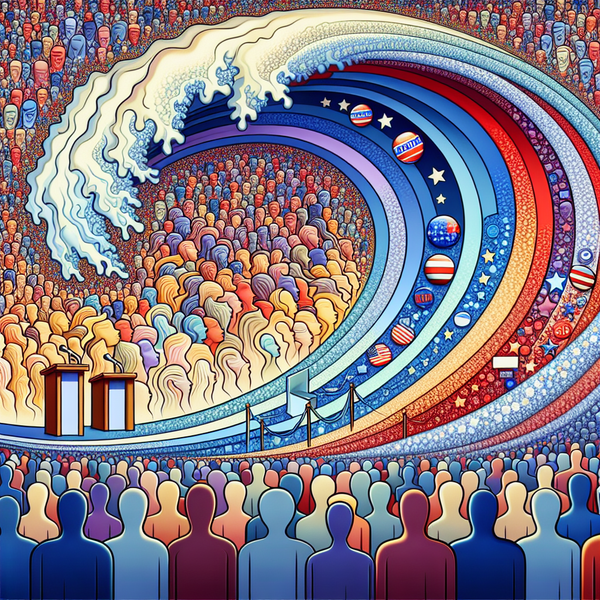The Evolution of Taxation Policy in the United States

The Unfolding Saga of Taxation Policy in the United States
Peering into the complex labyrinth of the United States' taxation policy can be likened to embarking on an endlessly intriguing journey. The tax landscape in America has continuously evolved, reflecting the nation's economic shifts, political ideologies, and social changes. The policy's transformation is a tale of adaptation and innovation, with each chapter characterized by its unique set of challenges and resolutions. To comprehend the current taxation system, we must first trace its roots and understand the dynamics that have shaped its course. Let's delve into the captivating narrative of the evolution of taxation policy in the United States, a chronicle where every turn and twist holds a profound impact on the nation's economic fabric.
Introduction to the Evolution of Taxation Policy in the United States
The taxation policy in the United States has evolved significantly over the centuries. This transformation has been facilitated by numerous factors such as economic conditions, political ideologies, societal changes, and the nation’s financial needs. From the implementation of the first income tax during the Civil War to the introduction of the modern tax code, the history of U.S. taxation policy provides fascinating insights into the country's economic evolution.
The Birth of Federal Taxation
The need for a federal taxation system surfaced during the American Revolution when the Continental Congress levied a tax on states to fund the war. However, this system was not efficient due to non-compliance by some states. After the ratification of the Constitution, the federal government gained the authority to impose taxes directly. The first significant federal tax was the Whiskey Tax of 1791, which led to the Whiskey Rebellion.
The Tariff Act of 1789
The Tariff Act of 1789 was another early form of federal taxation. It was primarily a protective tariff designed to shield domestic industries from foreign competition. Although it served as a primary source of federal revenue, it also led to regional tensions due to its impact on trade.
The Civil War and Income Tax
The Civil War led to the introduction of the first federal income tax in the U.S. in 1861. This tax was pivotal in raising funds for the war. Though it was repealed in 1872, it set the stage for the modern income tax system.
The 16th Amendment
In 1913, the 16th Amendment was ratified, granting Congress the power to levy taxes on income without apportionment among the states. This led to the formation of the modern federal income tax structure, which has since been a fundamental source of government revenue.
The Great Depression and New Deal Taxes
The Great Depression led to significant changes in U.S. tax policy. To fund the recovery programs of the New Deal, President Franklin D. Roosevelt implemented a series of tax reforms. These included the introduction of the Social Security tax, which still exists today.
The Revenue Act of 1935
Nicknamed the "Wealth Tax Act," the Revenue Act of 1935 significantly increased taxes on higher-income individuals and corporations. This act marked a progressive shift in U.S. tax policy, which had substantial implications for income inequality and wealth distribution.
Post-WWII Tax Reforms
The post-WWII period saw major tax reforms, including the introduction of automatic payroll withholding in 1943. These reforms simplified tax compliance and significantly increased government revenue.
The Tax Reform Act of 1986
The Tax Reform Act of 1986, signed by President Ronald Reagan, was one of the most significant tax overhauls in the 20th century. It simplified the tax code by reducing the number of tax brackets and eliminating many tax shelters and deductions.
Conclusion: The Evolution Continues
The evolution of U.S. taxation policy is a continuous process, shaped by the nation's changing economic, social, and political landscapes. Current debates around tax policy continue to center on issues such as economic inequality, corporate taxation, and the role of taxation in economic growth. The history of U.S. tax policy serves as a critical guide for understanding these ongoing debates and the possible future direction of U.S. taxation.
Use Case 1: Economic Scholars Studying Historical Taxation Policy
Economic scholars might use 'The Evolution of Taxation Policy in the United States' as a comprehensive guide to understand how the country's taxation policy has evolved over time. This can be particularly useful when analyzing the impact of different taxation models on the country's economic growth and stability. For example, they can study how the introduction of a federal income tax system in 1913, replacing the previous system of tariffs and excise taxes, impacted income distribution and economic investment. Or, they can analyze the tax cuts of the Reagan era to understand how they influenced economic growth and income inequality. Essentially, this historical overview provides a valuable context to interpret present-day economic conditions and predict future trends.
Use Case 2: Policy Makers Crafting New Tax Laws
Policy makers can use 'The Evolution of Taxation Policy in the United States' to gain insights into effective taxation strategies and the impact of different tax laws on the economy and societal welfare. While crafting new tax laws or reforming existing ones, they can use this historical context to avoid past mistakes and replicate successful strategies. For instance, if they are considering a proposal to simplify the tax code, they can look into the impact of the Tax Reform Act of 1986, which was the last major simplification of the U.S. tax code. They can study its effects on tax compliance, economic growth, and income distribution to make informed decisions.
Use Case 3: Educators Teaching American Economic History
Educators teaching American economic history or public policy might use 'The Evolution of Taxation Policy in the United States' as a teaching resource. It can provide students with a clear overview of the U.S. taxation policy's development, helping them understand the relationship between taxation, public spending, and economic growth. For example, educators can use this material to teach students about the shift from a reliance on indirect taxes to direct taxes. Or, they can discuss the introduction of progressive taxation and its impact on income inequality. This contextual understanding can help students develop a comprehensive understanding of American economic history and its implications for the present day. Title: The Evolution of Taxation Policy in the United States Introduction Taxation has been a critical component of the United States' financial system since its inception. The policies around taxation have evolved significantly, reflecting the changing economic, political, and social contexts of the country. This article explores the evolution of taxation policy in the United States, drawing from expert perspectives, various studies, and general consensus. Colonial Era to Civil War The United States' taxation policies can be traced back to the Colonial Era when the British imposed taxes on the colonies. The famous "No taxation without representation" slogan of the American Revolution was a response to these policies. After the formation of the United States, the new government primarily relied on tariffs and excise taxes, such as the controversial Whiskey Tax of 1791, which led to the Whiskey Rebellion. The Civil War significantly altered the U.S. tax landscape. The Union government introduced the Revenue Act of 1861, which instituted the first federal income tax in American history to fund the war effort. The Advent of the 16th Amendment The 16th Amendment, ratified in 1913, was a significant turning point in U.S. taxation policy; it allowed Congress to levy an income tax without apportionment among the states or basing it on the Census. This amendment paved the way for the modern income tax system, allowing for a progressive tax structure where those earning more paid higher tax rates. Post-War Era and Tax Reforms The conclusion of World War II ushered in an era of significant tax reforms, with a focus on wealth redistribution. The post-war period saw the highest tax rates in U.S. history, with the top marginal income tax rate peaking at 94% in 1944. The Reagan era brought significant changes, with the Economic Recovery Tax Act of 1981 slashing the top income tax rate from 70% to 50%. The Tax Reform Act of 1986 further reduced this to 28%, marking a shift towards lower tax rates for high earners. The 21st Century Tax Policy The 21st century has seen further changes in U.S. taxation policy. The Bush tax cuts of the early 2000s, followed by the Obama administration's extension of these cuts for middle and lower earners, signaled a continued emphasis on tax relief. The recent Tax Cuts and Jobs Act of 2017, enacted during the Trump administration, slashed corporate tax rates from 35% to 21%. Conclusion The evolution of taxation policy in the United States showcases a complex interplay of economic considerations, political ideologies, and societal needs. The future of taxation in the U.S. will undoubtedly continue to change in response to these factors, making it a fascinating area of study and discussion.
1. How has the taxation policy evolved in the United States?
The taxation policy in the United States has evolved significantly since the nation's founding. Initially, taxes were primarily on imports, exports, and property. However, the Civil War led to the introduction of income tax. The 16th Amendment in 1913 permanently established the federal income tax system. Post World War II, tax rates reached an all-time high, followed by various reforms and adjustments in the subsequent decades.
2. What was the first form of taxation in the United States?
The first form of taxation in the United States was tariffs on goods imported and exported. This was followed by property taxes. The first income tax was imposed during the Civil War to support war expenses.
3. When was the federal income tax system introduced?
The federal income tax system was introduced in 1913 with the ratification of the 16th Amendment to the U.S. Constitution. It allowed the federal government to levy an income tax on both corporate profits and personal income.
4. How did the taxation policy change post World War II?
Post World War II, the taxation policy in the United States underwent significant changes. The tax rates reached historic highs to fund war efforts. However, the subsequent years saw several tax reforms aiming to reduce the tax burden and simplify tax regulations.
5. What was the impact of the Tax Reform Act of 1986?
The Tax Reform Act of 1986 was one of the most significant tax reforms in U.S. history. It simplified the tax code by eliminating many deductions, reducing the number of tax brackets, and lowering tax rates. It also increased the standard deduction and personal exemption amounts.
6. How has the U.S. taxation policy evolved in the 21st century?
In the 21st century, the U.S. taxation policy has seen further changes with acts like the Bush tax cuts, the Affordable Care Act, and the Tax Cuts and Jobs Act of 2017. These changes aimed at reducing tax rates, changing tax brackets, and altering how certain types of income are taxed.
In conclusion, the evolution of taxation policy in the United States is an intricate tapestry woven through the fabric of the nation's history and development. It holds relevance across industries and time periods, influencing economic behaviors, shaping business decisions, and impacting personal finances. The varying taxation policies, from the inception of the nation to the present day, reflect the changing social, political, and economic landscapes. They have played a pivotal role in funding public infrastructure, services, and national defense, thus directly influencing the quality of life for U.S. citizens. For businesses, understanding these policies is crucial for strategic planning and compliance. Additionally, these policies can stimulate or hinder industry growth and innovation. For individuals and families, these policies directly affect disposable income, savings, and investments. Moreover, the evolution of taxation policy offers valuable insights for policy makers, economists, and historians alike. It helps to evaluate past strategies, understand their impact, and craft future policies. It also provides a reflection of societal values and priorities at different junctures in history. Therefore, the evolution of taxation policy in the United States is not merely a historical narrative, but a critical tool for understanding and navigating the economic realities of the present and the future. It's a testament to the nation's adaptability in the face of changing circumstances, and a roadmap for economic health and prosperity.



